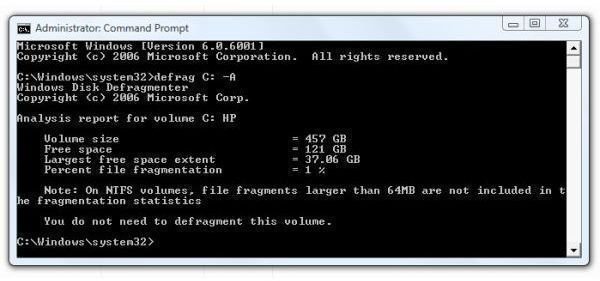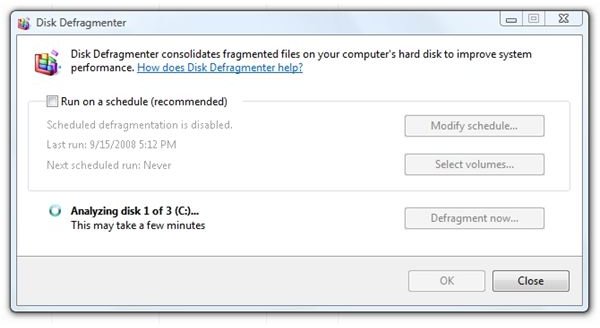How To Get A Detailed Fragmentation Report in Windows 7 or Vista - the Defrag Center
The Vista Defrag Center
The first time you thought about your PC’s hard drive possibly being fragmented, you probably went clicking around in the Start menu and Accessories looking for the defrag utility that you thought should be there. When you found it, were you a little nonplussed when you found this uninspiring application window?
The visual graphic of defragmenting in Windows XP is not included in Windows Vista or Windows 7.
This seems to be part of Windows’ bipolar nature. When you expect something impressive, like a full screen defragmentation utility that shows glowing and cleared blocks of data animated to show progress, you get a small dialog. When you expect nothing at all, Windows pops up a window in the system tray bragging that it’s retrieving the Program Guide.
And hey, at least they could have changed the icon.

Running a Scan Manually
Fortunately, the command-line abilities of the defrag utility can show more information. Here’s the result of a simple run.

We’ll return to this to get a more detailed report, but for the sake of caution, let’s…
Set a Windows Restore Point
In Windows, it’s a good idea to set a restore point, or go-back-to point, before installing new software or doing maintenance such as editing the registry, which may affect the stability of your PC.
Here’s the absolutely fastest way to create a restore point in Windows 7 and Vista that I’ve found:
1. Click start and type in “systempropertiesprotection”
2. If User Access Control is active, click Continue
3. Click Create
4. Enter a meaningful name for your restore point
5. Click Create and watch as it makes the restore point
6. Click OK to close the System Properties dialog.
Open an Elevated Command Prompt
Now, in order to get a more detailed report, we need to start an elevated command prompt. Do this: press the Start button on your keyboard and click on All Programs, then Accessories. Right-click “Command Prompt” and select “Run as administrator.”
While you’re at it, why not repeat the action and select Command Prompt, right-click, Pin to Program Menu. Many of the how-to articles and tips here on Bright Hub involved doing something at the command prompt with administrative privileges.
Run the Analysis
In the command prompt (DOS box), drag the lower edge to go to the full depth of your screen.
Then type in this command:
defrag C: -A -V
This translates into “perform fragmentation analysis on the C: drive and report your findings verbosely.”
This also takes a while to run. In fact, defrag in Windows Vista and Windows 7 is slow. Although we’re running it manually, remember that it was designed to be run as a background process. If you have a very large, very fragmented hard drive, feel free to do something else on your PC while it completes.
Why Does Disk Fragmentation Happen?
Fragmentation is a by-product of how the file system works. Ideally, all the data on a hard drive would be written sequentially, in a circular pattern on a platter on the drive, allowing for a direct, or bitwise, reading of the hard drive. When we delete a file, however, it may leave a gap in the smooth flow of data. Windows has no qualms about storing data in these gaps, even if it involves only putting part of a large file in the first gap it finds, another part in the next gap, etc. It’s sort of like trying to fit square pegs into a round hole.
When defragmentation reaches the point where dealing with it is causing too much movement of the read heads in the hard drive and really slowing down drive access, the disk needs to be defragged.
To be fair, Microsoft has gotten better and better at avoiding significant fragmentation, so the need to run defragmentation is much decreased in Vista and Windows 7.
Reading the Detailed Report
Here’s what the detailed report looks like.

So that’s a little bit fun. Information wants to be free, and we just set some loose.
What else can we do from the command line interface of defrag.exe?
Well, you can enter
defrag /?
to get a list of all the switches available. And, if you really do find you need to run the actual defrag, starting programs from the command prompt in Vista often allows them to run at a lower priority, and thus with a lower impact on the performance of your PC, than starting the same programs from the Vista screen interface. The backup utility, wbadmin.exe, for example, is one utility that runs much better from the command line.
Thank you for reading this, and thank you for visiting Bright Hub.
Further Reading
Label Your Cables to Avoid Confusion - Is your PC or stereo system a mess of mysterious cables and wires? Here we’ll look at a mid-range commercial labeler that would be at home on the factory floor or assembly room, but is also reasonable in helping manage a home computer or audiovisual system.
How to Set Up Simple Wireless Networking in Windows 7, Vista, and Windows XP - Want to set up the simplest wireless home network for your mixed Vista, XP, and Windows 7 computers? Want a network without a “boss” computer or cumbersome passwords that works even if some of the computers are not online and the simple rule for those that are connected is “share and share alike?”
Find Out if Your PC can run XP Mode in Windows 7 - “XP Mode” will allow users of the Professional, Enterprise, and Ultimate versions of Windows 7 to run mission-critical applications in a licensed copy of Windows XP on the desktop. There’s only one catch: the computer - both in the CPU and in the BIOS - must provide support for virtualization.
